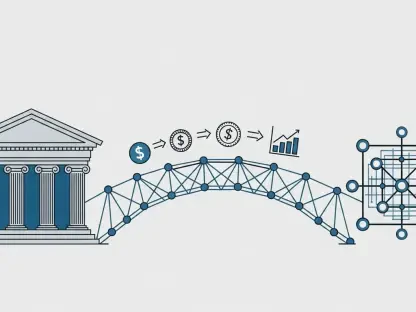In the heart of Zurich, Switzerland, the CV Summit 2025 recently unfolded as a defining moment for the intersection of blockchain and artificial intelligence (AI), drawing a global audience eager to witness the future of technology and finance. This two-day gathering convened over 1,700 blockchain-focused organizations and featured insights from 190 speakers, creating a dynamic forum for investors, founders, financial experts, and technologists. The event not only highlighted Switzerland’s pivotal role as a leader in innovation but also provided a platform to explore how these cutting-edge technologies are poised to transform industries on a massive scale. From reimagining wealth management to integrating digital assets into traditional systems, the Summit offered a glimpse into a rapidly evolving landscape. As discussions unfolded across various stages, it became clear that the synergy of blockchain and AI is no longer a distant vision but a tangible force reshaping global markets right now.
Redefining Finance with Wealt### Concepts
The concept of “Wealt###” emerged as a central theme at the Summit, encapsulating a bold new era where programmable money, tokenized assets, and AI-driven financial tools redefine how value is created and managed. Industry leaders from prominent institutions like Franklin Templeton emphasized the monumental shift from conventional account-based structures to digital wallet systems in wealth management. This transition promises greater flexibility and accessibility, allowing individuals and organizations to interact with financial systems in ways previously unimaginable. Beyond just theory, the discussions pointed to practical implications, such as streamlined global transactions that bypass traditional intermediaries. The notion of borderless finance, powered by these innovations, suggests a future where geographic barriers to wealth creation diminish, opening doors for broader participation in the global economy. This vision of Wealt### resonated across panels as a transformative framework that could fundamentally alter the financial landscape.
Complementing the Wealt### narrative was the focus on blockchain’s capacity to enhance efficiency in financial operations, particularly in payment systems. Experts highlighted how tokenized assets can simplify cross-border transfers, reducing costs and delays that have long plagued international finance. Meanwhile, AI’s integration into these systems was presented as a game-changer, with algorithms capable of optimizing investment strategies and personalizing financial services at scale. The synergy between blockchain’s transparency and AI’s analytical power was repeatedly underscored as a catalyst for trust and innovation. Unlike past discussions that often remained speculative, the Summit provided concrete examples of these technologies in action, from pilot programs to scalable solutions. This shift from concept to implementation signals that the financial sector is on the cusp of a profound evolution, driven by the seamless blending of technology and traditional practices, with Wealt### as the guiding principle.
Bridging Traditional Banking with Digital Assets
One of the most striking revelations at the Summit was the accelerating integration of digital assets into traditional banking frameworks, marking a significant milestone in the evolution of finance. A compelling example came from Luzerner Kantonal Bank, which now accepts major cryptocurrencies like Bitcoin and Ethereum as collateral for loans, demonstrating a tangible bridge between old and new financial paradigms. This move reflects a broader trend among Swiss institutions to embrace digital innovation while maintaining their reputation for stability and trust. Such developments challenge long-held assumptions about the separation of conventional and decentralized systems, showing that coexistence is not only possible but also beneficial. The implications are vast, potentially reshaping how loans, investments, and other financial instruments are structured in the years ahead.
Further illustrating this trend was a groundbreaking collaboration among key Swiss financial players, including major banks and associations, which achieved the first legally binding cross-institutional payment using deposit tokens on a public blockchain. This achievement is more than a technical feat; it represents a bold step toward mainstream adoption of blockchain infrastructure within regulated environments. The success of this initiative highlights Switzerland’s proactive stance in fostering an ecosystem where digital assets can thrive alongside traditional banking mechanisms. It also raises important questions about scalability and security as these systems expand to handle larger volumes of transactions. As more institutions follow suit, the line between digital and conventional finance continues to blur, paving the way for a hybrid model that could become the global standard. This integration stands as a testament to the practical impact of blockchain on real-world financial systems.
AI’s Financial Revolution and Its Complexities
Artificial intelligence took center stage at the Summit with discussions on its transformative potential in finance, particularly through autonomous financial agents designed to handle transactions and investments independently. These AI systems, capable of executing complex decisions without human intervention, promise to revolutionize efficiency in wealth management and payment processing. Panels dedicated to AI explored how such agents could personalize financial advice and optimize portfolios in real time, offering unprecedented levels of customization. However, beneath the excitement lies a critical need to address how these systems align with ethical standards and user trust. The sheer autonomy of AI agents sparked debates on their role in reshaping financial interactions, with a clear consensus that their adoption must be accompanied by robust oversight to prevent unintended consequences in the marketplace.
Equally significant was the emphasis on blockchain as a foundational technology to support AI’s integration into finance, ensuring transparency and accountability in automated processes. With tech giants like Google and Microsoft contributing to these conversations alongside blockchain platforms such as Ethereum, the Summit showcased a powerful convergence of expertise. The dialogue revealed a shared understanding that while AI holds immense promise, challenges like data privacy and decision-making accountability remain unresolved. Unlike earlier discussions that focused solely on potential, this year’s event delved into actionable strategies for mitigating risks, such as leveraging blockchain’s immutable records to track AI actions. These insights reflect a maturing perspective on AI’s role in finance, balancing enthusiasm with a pragmatic approach to governance. As these technologies advance, their combined impact could redefine trust and efficiency in financial ecosystems worldwide.
Switzerland’s Pioneering Role in Tech Innovation
Switzerland’s reputation as a global leader in blockchain innovation was a recurring focus at the Summit, underscored by its vibrant ecosystem of over 1,700 blockchain entities. Government and industry figures alike called for decisive action in areas like stablecoin adoption and tokenization, urging the nation to maintain its competitive edge through forward-thinking policies. This leadership is not just about numbers but also about a cultural willingness to experiment, as evidenced by a mindset that views both successes and setbacks as critical learning opportunities. The Summit painted a picture of a country uniquely positioned to shape the future of decentralized technologies, with its blend of institutional trust and technological ambition serving as a model for others. This environment fosters collaborations that could set global benchmarks for innovation in the coming years.
Beyond its domestic achievements, Switzerland’s role as a hub for international dialogue was evident in the diverse perspectives shared at the event, reinforcing its status as a neutral ground for pioneering ideas. Industry leaders stressed the importance of regulatory clarity to support rapid advancements without compromising security or public confidence. Unlike other regions where regulation often lags behind technology, Switzerland’s proactive approach—seen in initiatives like government-backed blockchain projects—offers a blueprint for balancing innovation with stability. The push for bold steps in digital asset adoption also highlighted a broader vision of sustaining global leadership through adaptability. As the Summit demonstrated, Switzerland is not merely reacting to technological trends but actively driving them, creating a ripple effect that influences how other nations approach the integration of blockchain and AI into their economic frameworks.
Global Reach and Tangible Applications
The global impact of blockchain and AI was a vital discussion point at the Summit, with a particular emphasis on their potential to drive financial inclusion in emerging markets across continents. Case studies from regions like Africa and the Middle East illustrated how these technologies can provide access to financial services for underserved populations, effectively bridging economic divides. Leaders from diverse locales, including Dubai, shared frameworks for building robust digital asset ecosystems that prioritize inclusivity and growth. These insights underscored a universal truth: blockchain and AI are not confined to developed economies but hold transformative power for communities worldwide. The international dialogue at the event emphasized that tailored solutions, informed by local contexts, are essential for maximizing the benefits of these technologies on a global scale.
In addition to broad societal impacts, the Summit spotlighted real-world applications through startup innovations and strategic partnerships that address concrete challenges. Fireside chats with entities like Sygnum Bank explored the maturation of tokenized value exchange, while sessions with venture capitalists examined preparations for decentralized financial futures. Unlike abstract discussions of potential, these presentations focused on actionable outcomes, such as secure cross-border aid transfers and verifiable data systems developed by emerging companies. The diversity of attendees—from tech giants to small innovators—ensured a rich exchange of ideas, highlighting how collaboration across sectors can accelerate the adoption of blockchain and AI. This focus on practical impact reflects a shift toward implementation, demonstrating that these technologies are already reshaping industries and communities in meaningful ways.
Shaping Tomorrow’s Financial Landscape
Looking back at the CV Summit 2025, it became evident that blockchain and AI have transcended speculative concepts to become active catalysts of a new financial paradigm characterized by borderless, programmable money and intelligent systems. The event, hosted in Zurich, successfully bridged the gap between traditional financial institutions and tech innovators, fostering collaborations that were once deemed unlikely. Switzerland’s leadership, backed by over 1,700 blockchain entities and progressive policies, stood out as a driving force, though the call to sustain this momentum through continuous innovation was unmistakable. Partnerships with global players like Franklin Templeton and Binance further highlighted the importance of collective effort in navigating this transformative era.
Reflecting on the discussions, the next steps involve deepening the integration of AI and blockchain into everyday financial systems while addressing governance and scalability challenges head-on. Stakeholders must prioritize developing frameworks that ensure transparency and trust, particularly for autonomous financial agents. Additionally, expanding pilot programs like deposit token payments into broader applications could solidify the hybrid model of digital and traditional finance. As the groundwork laid at the Summit continues to evolve, platforms for dialogue and experimentation will remain crucial in steering these technologies toward inclusive, sustainable outcomes. The path forward demands a commitment to balancing innovation with responsibility, ensuring that the financial landscape of tomorrow benefits all corners of the globe.









